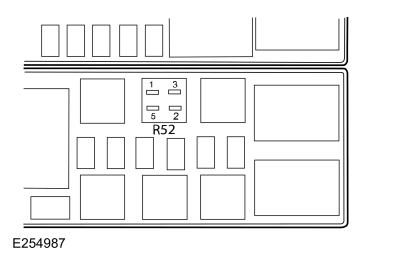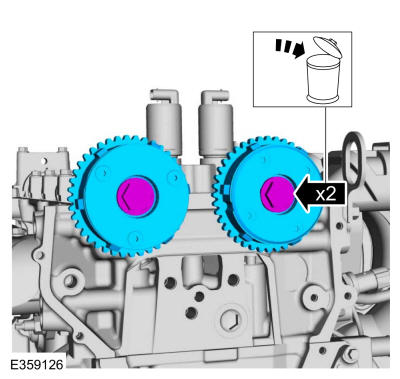Refer to Wiring Diagrams Cell 44 for schematic and connector information.
Normal Operation and Fault Conditions
REFER to: Horn - Overview (413-06 Horn, Description and Operation).
DTC Fault Trigger Conditions
| DTC |
Description |
Fault Trigger Condition |
| BCM B1C55:12 |
Horn Relay: Circuit Short To Battery |
Sets when the BCM detects a short to voltage from the horn relay
control circuit. The BCM disables the horn when this DTC is set.
|
| BCM B1C55:14 |
Horn Relay: Circuit Short To Ground Or Open |
Sets when the BCM detects an open from the horn relay control circuit.
|
Possible Sources
- Fuse
- Wiring, terminals or connectors
- Clockspring
- Horn
- Horn relay
- Driver airbag
- Steering wheel
-
BCM
Visual Inspection and Pre-checks
- Verify BJB fuses 11 (5A), 28 (10A) and 29 (10A) are OK.
NOTICE:
Use the correct probe adapter(s) when making
measurements. Failure to use the correct probe adapter(s) may damage the
connector.
NOTICE:
The following pinpoint test uses a test lamp to simulate
normal circuit loads. Use only a Rotunda Test Lamp (SGT27000) or
250-300mA incandescent bulb test lamp. To avoid connector terminal
damage, use the Rotunda Flex Probe kit for the test lamp probe
connection to the vehicle. Do not use the test lamp probe directly on
any connector.
|
| A1 CHECK THE BCM (BODY CONTROL MODULE)
OUTPUT BY ACTIVATING THE BCM (BODY CONTROL MODULE)
HORN_RELAY PID (PARAMETER IDENTIFICATION)
|
-
Using a diagnostic scan tool, view the BCM Parameter Identifications (PIDs).
-
Select the active command BCM HORN_RELAY PID and command the horn ON and then OFF.
Do the horns sound when commanded ON?
|
| A2 CHECK THE HORN RELAY |
-
Carry out the component test on the horn relay.
Refer to Wiring Diagrams Cell 149 for schematic and connector information.
Did the horn relay pass the component test?
| No |
INSTALL a new horn relay.
|
|
| A3 CHECK THE HORN RELAY VOLTAGE SUPPLY CIRCUITS FOR AN OPEN |
-
Connect:
|
Lead 1
|
Measurement / Action
|
Lead 2
|
 Horn relay, cavity 1
Horn relay, cavity 1
|

|
Ground
|
 Horn relay, cavity 3
Horn relay, cavity 3
|

|
Ground
|
Does the test lamp illuminate when connected?
| No |
Verify BJB
fuse 11 (5A) is OK. If OK, REPAIR the circuit in question. If not OK,
REFER to the Wiring Diagrams to identify the possible causes of the
circuit short.
|
|
| A4 CHECK THE HORN RELAY OUTPUT |
-
Connect:
|
Lead 1
|
Measurement / Action
|
Lead 2
|
 Horn relay, cavity 3
Horn relay, cavity 3
|

|
 Horn relay, cavity 5
Horn relay, cavity 5
|
-
Remove the fused jumper wire.
Do the horns sound when the jumper wire is connected?
|
| A5 CHECK THE HORN VOLTAGE CIRCUIT FOR AN OPEN |
-
Disconnect Left Horn C1101
.
-
Disconnect Right Horn C1102
.
-
Measure:
Click to display connectors
|
Lead 1
|
Measurement / Action
|
Lead 2
|
|
C1101-2
|

|
Horn relay, cavity 5
|
|
C1102-2
|

|
Horn relay, cavity 5
|
Is the resistance less than 3 ohms?
| No |
Verify BJB fuses 28 (10A) and 29 (10A) are OK. If
OK, REPAIR the circuit in question. If not OK, REFER to the Wiring
Diagrams to identify the possible causes of the circuit short.
|
|
| A6 CHECK THE HORN GROUND CIRCUIT FOR AN OPEN |
-
Measure:
Click to display connectors
|
Lead 1
|
Measurement / Action
|
Lead 2
|
|
C1101-1
|

|
Ground
|
|
C1102-1
|

|
Ground
|
Is the resistance less than 3 ohms?
| Yes |
INSTALL new horns.
REFER to: Horn (413-06 Horn, Removal and Installation).
.
|
|
| A7 CHECK THE HORN RELAY COIL CONTROL CIRCUIT FOR A SHORT TO VOLTAGE |
-
Measure:
|
Positive Lead
|
Measurement / Action
|
Negative Lead
|
 Horn relay, cavity 2
Horn relay, cavity 2
|

|
Ground
|
Is any voltage present?
|
| A8 CHECK THE HORN RELAY CONTROL CIRCUIT FOR AN OPEN |
-
Measure:
|
Positive Lead
|
Measurement / Action
|
Negative Lead
|
 Horn relay, cavity 2
Horn relay, cavity 2
|

|
C2280E-18
|
Is the resistance less than 3 ohms?
|
| A9 CHECK THE BCM (BODY CONTROL MODULE)
HORN SWITCH INPUT |
-
Connect:
Click to display connectors
|
Lead 1
|
Measurement / Action
|
Lead 2
|
|
C226A-9
|

|
Ground
|
-
Remove the fused jumper wire.
Do the horns sound when the jumper wire is connected?
|
| A10 CHECK THE BCM (BODY CONTROL MODULE)
HORN SWITCH INPUT CIRCUIT FOR AN OPEN |
-
Measure:
Click to display connectors
|
Positive Lead
|
Measurement / Action
|
Negative Lead
|
|
C2280D-26
|

|
C226A-9
|
Is the resistance less than 3 ohms?
|
| A11 CHECK THE CLOCKSPRING GROUND CIRCUIT FOR AN OPEN |
-
Measure:
Click to display connectors
|
Positive Lead
|
Measurement / Action
|
Negative Lead
|
|
C226A-8
|

|
Ground
|
Is the resistance less than 3 ohms?
|
| A12 ISOLATE THE HORN SWITCH |
-
Remove the driver airbag.
REFER to: Driver Airbag (501-20B Supplemental Restraint System, Removal and Installation).
-
Connect:
|
Lead 1
|
Measurement / Action
|
Lead 2
|
|
C217A-1
|

|
C217A-2
|
-
Remove the fused jumper wire.
Do the horns sound when the jumper wire is connected?
| Yes |
INSTALL a new driver airbag (includes horn switch).
REFER to: Driver Airbag (501-20B Supplemental Restraint System, Removal and Installation).
|
|
| A13 CHECK HORN OPERATION WITH STEERING WHEEL HARNESS ISOLATED |
-
Disconnect Clockspring C218B
.
-
Connect:
|
Lead 1
|
Measurement / Action
|
Lead 2
|
|
Clockspring C218B, pin 4, component side
|

|
Clockspring C218B, pin 5, component side
|
-
Remove the fused jumper wire.
Do the horns sound when the jumper wire is connected?
| Yes |
INSTALL a new steering wheel (includes steering wheel wiring harness).
REFER to: Steering Wheel (211-04 Steering Column, Removal and Installation).
|
| No |
INSTALL a new clockspring.
REFER to: Clockspring (501-20B
Supplemental Restraint System, Removal and Installation). TEST the
system for normal operation. If the horns are still inoperative, INSTALL
a new SCCM .
|
|
| A14 CHECK FOR CORRECT BCM (BODY CONTROL MODULE)
OPERATION |
-
Disconnect and inspect the BCM connectors.
-
Repair:
-
corrosion (install new connectors or terminals - clean module pins)
-
damaged or bent pins - install new terminals pins
-
pushed-out pins - install new pins as necessary
-
Reconnect the BCM connectors. Make sure they seat and latch correctly.
-
Operate the system and determine if the concern is still present.
Is the concern still present?
| Yes |
CHECK OASIS for any applicable Technical Service Bulletins (TSBs). If a
TSB exists for this concern, DISCONTINUE this test and FOLLOW TSB
instructions. If no Technical Service Bulletins (TSBs) address this
concern, INSTALL a new BCM. Refer to the appropriate Removal and
Installation procedure in Section 419-10.
|
| No |
The system is operating correctly at this time. The
concern may have been caused by module connections. ADDRESS the root
cause of any connector or pin issues.
|
|
 PINPOINT TEST A: THE HORNS ARE INOPERATIVE
PINPOINT TEST A: THE HORNS ARE INOPERATIVE  PINPOINT TEST B: A SINGLE HORN IS INOPERATIVE
PINPOINT TEST B: A SINGLE HORN IS INOPERATIVE PINPOINT TEST C: THE HORNS ARE ALWAYS ON
PINPOINT TEST C: THE HORNS ARE ALWAYS ON Description and Operation - Horn - System Operation and Component Description
Description and Operation - Horn - System Operation and Component Description Removal and Installation - Horn
Removal and Installation - Horn
 PINPOINT TEST A: THE HORNS ARE INOPERATIVE
PINPOINT TEST A: THE HORNS ARE INOPERATIVE  Horn relay, cavity 1
Horn relay, cavity 1




